
Full text loading...
 , Tongcheng Han1,2
, Tongcheng Han1,2 , Li‐Yun Fu1,2
, Li‐Yun Fu1,2
Seismic waves propagating in a fractured porous rock with fluids can be greatly attenuated due to the wave‐induced fluid flow, including the macroscopic Biot flow, the mesoscopic interlayer fluid flow and the microscopic squirt flow. However, the comprehensive effects of the above wave‐induced fluid flows on the frequency‐dependent seismic properties in layered and fractured rocks with partial saturation are still poorly understood. To obtain such knowledge, we present a superposition approach accounting for the dispersion and attenuation induced by the multi‐scale wave‐induced fluid flows in the above‐mentioned target rocks, and study the influences of the water saturation, layer thickness ratio and fracture properties (i.e. fracture density and fracture aspect ratio) on the frequency‐dependent vertical P‐wave velocity (VP0). The results demonstrate that the increasing water saturation enhances the dispersion and attenuation of VP0 in the full frequency band, and the varying layer thickness ratio not only affects the dispersion and attenuation induced by the interlayer fluid flow, but also influences those caused by the Biot flow and squirt flow. The fracture properties are also found to significantly impact the seismic properties of the target rock. In addition to its effects on the squirt flow, the increasing fracture density is shown to weaken the dispersion and attenuation induced by the Biot flow, and enhance those caused by the interlayer fluid flow. The obtained results provide new insights into the frequency‐dependent seismic properties in the partially saturated layered rocks with fractures, and the knowledge gained from these results has important practical applications for the successful interpretation of fluid and fracture properties applying the seismic exploration data acquired in fractured reservoirs.

Article metrics loading...

Full text loading...
References


Data & Media loading...

